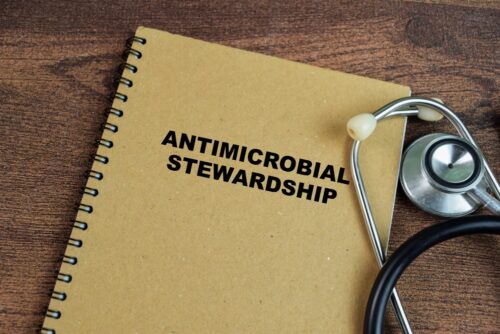Antibiotics have become the cornerstone of treatment for infections in veterinary medicine. They have been widely used as life-saving treatments for our pets suffering from infectious diseases! But, with the rise of antibiotic administration to pets, a global crisis has come about that may negatively impact the positive benefit of antibiotics for the treatment of pathogenic infections in our pets.
Antibiotics are very effective at treating pathogenic infections in pets. They work by killing bacteria that are contributing to an infection to mitigate their impact and stop them from spreading. (1) Some antibiotics can work for multiple types of pathogens, while others can only fight against specific bacteria. Overall, the goal of antibiotics is to allow our pets to have a better chance of fighting off infections.
BUT- despite the revolutionary impact antibiotics have had on veterinary medicine, veterinary practitioners face a major crisis- Antimicrobial Resistance.
As antibiotic use has increased significantly in recent years, pathogens have progressively become resistant to this type of medication. This is referred to as Antimicrobial Resistance (AMR), or when a pathogenic microbe no longer responds to an antibiotic the way it once did due to repeated or over exposure. (2) Pathogens essentially become familiar with the antibiotic and can genetically modify or adapt to become resistant to their effects as a way to evade being killed off.
Essentially, AMR is a consequence of the battle between nature and science; bacteria attempt to evade weakening or killing from an antibiotic- the AMR- and clinicians and scientists must find ways to counteract this evasion. The more antibiotics become standard treatment practice for veterinary professionals, the more frequently common antibiotics are used as treatment, and the more likely our pets are to become resistant to treatment efficacy.
AMRs have become a global crisis- today, there is a clinically significant AMR against virtually every common antibiotic deployed.
So, the question is- how can veterinary professionals counteract AMRs and still treat their patients?

One way practitioners have counteracted AMRs is by modulating the type, dose, and route of antibiotics given for a particular pathogen. Typically, a diagnostic culture test is used to identify which pathogen is contributing to a particular clinical outcome. (3) Rather than identifying a pathogen and prescribing a standard dose of an antibiotic in a typical administration technique (i.e., topical administration), clinicians can re-assess the type, dose, and route (i.e., oral versus subcutaneous) of the drug that may be best to administer.
Let’s say a pet comes in to see their doctor for diarrhea symptoms. Their doctor postulates that a pathogen is contributing to diarrhea, likely Escherichia coli (E. coli), and chooses to run this culture to see if their guess is accurate. They found an abnormally high concentration and prescribed an antibiotic to kill the E. coli. However, the initial dosage does not appear to make a difference in the pet’s symptoms. This could be because the antibiotic they were administered is one that this pet has an AMR gene for, or that the dosage is not high enough to make a significant impact. The owner brings their patient into their doctor again, and, this time, the doctor augments their prescription to a higher dosage or a similar, yet seemingly more effective type of antibiotic. And the good news is that this modification works, and their diarrhea resolves!
However, there are a few problems here:
- The pet in this example ended up having to be on antibiotics for MUCH longer than anticipated. One of the unintended consequences of the overuse of antibiotics is an unfavorable disruption in the pet’s microbiome, which likely will impact their health in the long run. This is because overuse of antibiotics can lead to an overall reduction in microbial diversity, with a potential overgrowth of pathobionts (like Clostridioles difficile) and a reduction in beneficial commensals (like Clostridium hiranonis). Not only that, but overuse of antibiotics can increase AMRs over time.
- There may be other pathogens that are also contributing to diarrhea that the culture test is not able to detect. If this is the case, then there is a chance that the pet’s diarrhea may come back.
These two problems justify the need for a better, more effective diagnostic technique than culture – Genomic Testing.
One of the biggest struggles with microbial detection of pathogens in veterinary practice is the fact that traditional techniques to identify pathogens- like culturing- can only identify 1-3% of all the microbes that exist and even fewer fungi. Not only that, but veterinary professionals have to have an educated guess of which pathogen they think is the culprit and choose to test that pathogen with culture. Using culture techniques essentially creates an echo chamber, in which only the most common pathogens are ever tested, and the most common antibiotics are typically administered.
If veterinary professionals continue to use culture to identify pathogens, they are really only identifying an incredibly small percentage of pathogens that could potentially be contributing to a disease and potentially missing the mark when it comes to administering the most effective treatment!
As an alternative approach, genomic testing like Next-Generation Sequencing (NGS) is likely more effective at identifying the exact pathogen- bacteria or fungus– that is contributing to an infectious disease in pets. (4) Not only that, but NGS is well-known for being able to detect existing AMRs in an individual pet. (5,6) This way, the clinician can prescribe the right kind of antibiotic at the appropriate dose, AVOIDING the ‘trial and error’ period that often occurs with culture test.
Using NGS to can be a better way to treat infections by:
- Allowing for the identification of specific pathogens, common and uncommon, that are likely contributing to a clinical outcome.
- Providing more accurate, individualized information about an animal’s AMRs so as to more effectively prescribe antibiotics if needed.
- Reducing the time/exposure to antibiotics while still improving the treatment efficacy, which can lead to reduced resistance to antibiotics in the future! This is particularly important, given the recent argument that reduced exposure to antibiotics may be better for pets in the long run. (7)
Fortunately, MiDOG Animal Diagnostics provides not only a more specific breakdown of a pet’s microbiome (bacteria) and mycobiome (fungi) to identify virtually all pathogens that could be contributing to an infectious disease, but also a detailed AMR panel to provide the clinician a roadmap detailing which antibiotics would be best for their patient- potentially skipping the trial and error period, reducing time on antibiotics, and increasing treatment efficacy for their patients!
References:
https://www.nps.org.au/consumers/antibiotics-explained#how-do-antibiotics-work?
https://www.who.int/news-room/fact-sheets/detail/antimicrobial-resistance
Palma, E., Tilocca, B., & Roncada, P. (2020). Antimicrobial Resistance in Veterinary Medicine: An Overview. International journal of molecular sciences, 21(6), 1914. https://doi.org/10.3390/ijms21061914
Cohen, A., Bont, L., Engelhard, D., Moore, E., Fernández, D., Kreisberg-Greenblatt, R., … & Hays, J. P. (2015). A multifaceted ‘omics’ approach for addressing the challenge of antimicrobial resistance. Future microbiology, 10(3), 365-376.
Saracino, I. M., Pavoni, M., Zullo, A., Fiorini, G., Lazzarotto, T., Borghi, C., & Vaira, D. (2021). Next generation sequencing for the prediction of the antibiotic resistance in Helicobacter pylori: a literature review. Antibiotics, 10(4), 437.
Sun, T., Wu, X., Cai, Y., Zhai, T., Huang, L., Zhang, Y., & Zhan, Q. (2021). Metagenomic next-generation sequencing for pathogenic diagnosis and antibiotic management of severe community-acquired pneumonia in immunocompromised adults. Frontiers in cellular and infection microbiology, 11, 661589.
Llewelyn, M. J., Fitzpatrick, J. M., Darwin, E., Gorton, C., Paul, J., Peto, T. E., … & Walker, A. S. (2017). The antibiotic course has had its day. Bmj, 358.
Categories: Antimicrobial Resistance, Next-Gen DNA Sequencing Technology, Veterinarian Guides, Veterinary Best Practices

